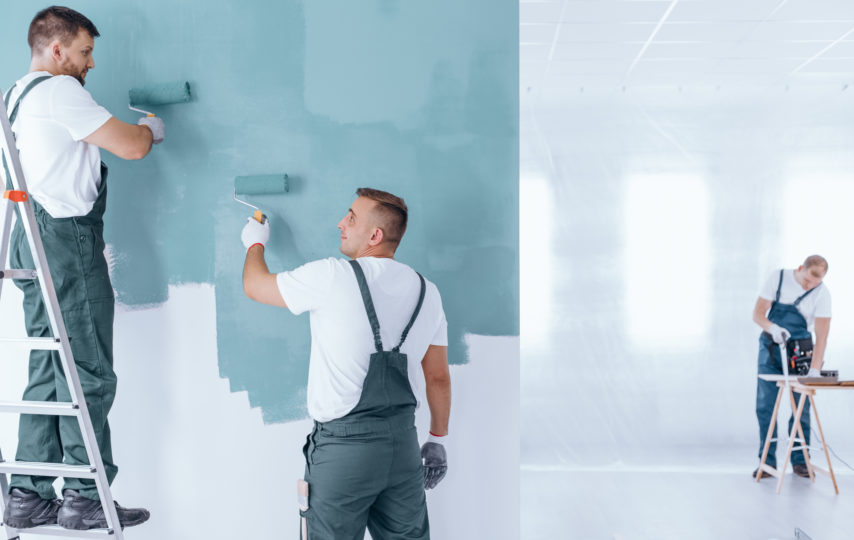Painting a wall can be a daunting task, especially if you’ve never done it before. But with the right tips for painting a wall, you can make your house painting project look like it was done by a professional! In this blog post, we will discuss 10 proven tips for painting a wall that will make your house look amazing. With these tips for painting a wall, you’ll have a wall that looks like it was painted by an expert in no time. So read on to learn how to paint a wall like a pro!
1) Tools of the Trade
When it comes to painting a wall, having the right tools is key to achieving a professional-looking finish. Here are some essential tools and equipment that you’ll need for the job:
1. Paint rollers and brushes – Depending on the size of the wall, you’ll need to use either a paint roller or brush to apply the paint. A roller is best for large areas, while a brush is ideal for cutting in around edges and corners.
2. Paint tray – This is where you pour your paint and load up your roller or brush. Look for a sturdy, deep tray that will hold enough paint without spilling or dripping.
3. Painter’s tape – To ensure clean, sharp lines around window frames, baseboards, and other trim, use painter’s tape to mask off these areas before painting.
4. Drop cloths – Painting can be messy, so protect your floors and furniture with drop cloths or old sheets. Be sure to cover everything within the room that isn’t going to be painted.
5. Sandpaper – If you’re painting over a previously painted wall, it’s important to smooth out any rough spots or imperfections. Use sandpaper to lightly sand the surface before applying the new coat of paint.
By having the right tools and equipment on hand, you’ll be well on your way to achieving a flawless finish when painting a wall. Remember, taking your time with each step and being patient is key to achieving professional results. Stay tuned for our next tip – choosing the right paint for the job!
2) The Right Paint
Choosing the right paint is a crucial aspect of painting a wall. With so many different types of paints available in the market, it can be quite overwhelming to choose the right one. Here are a few painting a wall tips to help you make the right choice.
First and foremost, consider the room and the type of wall you are painting. If the room experiences high traffic or moisture, it’s best to use a durable paint that can withstand wear and tear. For instance, if you are painting a kitchen or bathroom wall, consider using a moisture-resistant paint.
Secondly, choose the right finish for your paint. Glossy finishes are great for high-traffic areas, while matte finishes are perfect for hiding imperfections. You may also opt for a satin or eggshell finish that provides a slight sheen while still being easy to clean.
Thirdly, always test the paint before you start painting the entire wall. You can get a small sample of the paint and apply it to a small area of the wall to see how it looks in different lighting conditions. This will help you avoid any unpleasant surprises after the painting is done.
Finally, invest in a quality paint that will last you for years to come. Cheap paints may save you money in the short run, but they often require multiple coats and wear off easily, resulting in the need for frequent repainting.
By keeping these painting a wall tips in mind, you can choose the right paint that not only meets your needs but also ensures a smooth and lasting finish.
3) Prep Work
One of the most important aspects of painting a wall is the prep work. By taking the time to properly prepare your walls before you start painting, you can ensure that your finished product looks professional and flawless. Here are a few painting a wall tips for prep work that can help you get started:
1. Clean your walls thoroughly: Before you begin painting, make sure to clean your walls thoroughly. Use a damp cloth or sponge to wipe down the surface and remove any dust, dirt, or grime that might be present. This will ensure that your paint adheres properly to the surface.
2. Repair any damage: If your walls have any cracks, holes, or other damage, be sure to repair them before you begin painting. Use spackling compound to fill in any holes or cracks, and sand the surface smooth before painting.
3. Cover any areas you don’t want to paint: Use painter’s tape to cover any areas that you don’t want to paint, such as trim, molding, or window frames. This will help you create clean, straight lines and avoid accidental drips or splatters.
4. Sand the surface: If your walls are already painted, use sandpaper to rough up the surface before you start painting. This will help the new paint adhere better to the surface and create a smoother finish.
5. Prime the walls: If you are painting over a dark or heavily textured surface, consider using a primer before you start painting. This will help create an even surface and ensure that your finished product looks flawless.
By taking the time to properly prep your walls before you begin painting, you can help ensure that your finished product looks professional and flawless. Use these painting a wall tips to get started, and you’ll be well on your way to a beautifully painted room in no time.
4) Cutting In
When painting a wall, one of the most important steps is called “cutting in.” This is where you paint the areas around the edges of the wall that can’t be reached with a roller or brush.
To cut in, you’ll need a good quality angled brush and some painter’s tape. The tape will help keep your edges straight and prevent you from accidentally getting paint on other surfaces.
Start by placing the tape along the edges of the wall, making sure it’s straight and secure. Then dip your brush into the paint and carefully paint along the edge of the tape, creating a straight line.
Be sure to apply enough pressure to the brush to get good coverage, but not so much that it smudges or drips. Work in small sections, moving from top to bottom or left to right, depending on your preference.
If you make a mistake or get paint on the tape, don’t panic. Simply wipe it off with a damp cloth or paper towel and try again.
Once you’ve cut in all the edges of the wall, remove the tape while the paint is still wet. This will give you clean, straight lines and a professional-looking finish.
With these tips for cutting in, your walls will look like they were painted by a pro.
5) Time to Paint
Once you have completed all the necessary prep work, it’s time to start painting! Here are some tips to help you achieve a smooth, even finish:
1. Use a paint tray: Pour a small amount of paint into a paint tray and dip your roller into it. Be sure to evenly distribute the paint on the roller to avoid drips or globs on the wall.
2. Roll in a W shape: Start rolling the paint onto the wall in a W shape, and then fill in the spaces in between. This will help you avoid leaving lines or roller marks on the wall.
3. Use the right pressure: Apply gentle pressure when rolling the paint onto the wall. Pressing too hard can create uneven patches or cause the paint to drip.
4. Work in small sections: Rather than trying to paint the entire wall in one go, work in small sections. This will help you to keep a consistent finish and avoid overlaps or missed spots.
5. Blend wet edges: When painting a large area, be sure to blend the wet edges of each section as you go along. This will help you avoid creating lines or blotches on the wall.
6. Keep a wet edge: Try to maintain a wet edge as you work. This means painting over the edges of the last section you painted while it is still wet, to blend the paint together.
7. Watch out for drips: Keep an eye out for drips or pooling paint. Use a clean brush or roller to quickly smooth out any mistakes.
By following these tips, you can achieve a smooth and professional-looking finish on your painted walls. Remember to take your time and work carefully, and you’ll be rewarded with beautiful results!
6) Clean Up
Cleaning up after painting is often an overlooked step, but it’s crucial to ensure that your tools and workspace are in top condition for your next project. Here are some tips to make cleaning up a breeze:
1. Clean your brushes and rollers immediately after use. Use warm, soapy water to clean your brushes and rollers thoroughly. Rinse them off with clean water, and pat them dry with a clean towel.
2. Dispose of any used paint cans and leftover paint properly. Do not pour paint down the drain, as this can harm the environment. Check with your local recycling center or hazardous waste facility for proper disposal instructions.
3. Wipe down any spills or drips. If you accidentally spill or drip paint on the floor, wipe it up with a damp cloth immediately.
4. Clean your workspace. Wipe down any surfaces that may have come in contact with paint. Vacuum any paint dust or debris from the floor.
5. Store your tools properly. Store your brushes and rollers in their original packaging or wrap them in plastic wrap to prevent them from drying out.
By following these simple steps, you’ll keep your tools and workspace clean and ready for your next painting project.
7) Let It Dry
Once you have applied your final coat of paint, it is essential to let it dry completely. Rushing the drying process can lead to a range of problems, including drips, smudges, and uneven spots. Depending on the type of paint you have used, drying time can vary, but typically you should wait for at least 24 hours before touching the painted surface.
If you are in a hurry and need to speed up the drying process, you can use a fan or open windows to help circulate the air. However, be cautious as too much air movement can also create imperfections. Before you touch or apply anything to the painted surface, make sure to test a small area to ensure that it is fully dry.
Once the paint is dry, carefully remove the painter’s tape from any trim or surfaces you protected earlier. Be gentle when peeling the tape off to prevent any damage to the painted area. Finally, inspect your work for any missed spots or areas that need touching up. Take your time and make sure everything is perfect before moving onto the final step.
With the painting process complete and the walls dry, your room will look refreshed and brand new. You can now move your furniture back in, hang up your pictures, and enjoy your beautifully painted space. Remember to store any leftover paint properly for future touch-ups or projects.
8) Check for Mistakes
Now that you’ve finished painting your wall, it’s time to inspect it for any mistakes or imperfections. This step is crucial in ensuring that your finished project looks professional and flawless. Here are some tips on what to look for when checking for mistakes:
1. Uneven paint coverage: Take a step back and look at your wall from different angles. Is the paint evenly applied or are there any patches that need touching up?
2. Drips and splatters: Check for any drips or splatters that may have occurred during the painting process. These can be easily corrected by using a small brush to blend them in.
3. Bleeding paint: Check for any areas where the paint may have bled through the painter’s tape or where two different colors meet. Use a small brush to touch up these areas.
4. Brush marks and roller lines: Look for any visible brush marks or roller lines that may have been left behind. Smooth these out with a clean, dry roller or brush.
5. Overspray: Check for any areas where paint may have accidentally sprayed onto surrounding surfaces. These can be removed with a damp cloth.
By taking the time to check for mistakes, you’ll be able to correct any imperfections and achieve a flawless finish. Remember, a little extra time spent checking can save you from having to do touch-ups later on!
9) Add the Finishing Touches
Once you’ve finished painting the wall, take a few extra minutes to add some finishing touches. These small details can make a big difference in the overall appearance of your room. Here are a few ideas to consider:
1. Touch up the trim: If you painted around window and door frames or baseboards, go over them again with a small brush to make sure the lines are crisp and clean.
2. Add an accent color: Consider painting one wall a different color to create an accent wall. This can add interest and depth to a room.
3. Hang artwork: A freshly painted wall is the perfect canvas for artwork. Hang a few pieces to add color and personality to the space.
4. Change up the lighting: The way your wall looks can change depending on the lighting in the room. Try out different lightbulbs or add a new fixture to highlight your newly painted wall.
5. Consider texture: Depending on the type of paint you used, you may be able to add texture to the wall by using a special brush or roller. This can add depth and interest to the wall.
Taking the time to add these finishing touches can make your room look polished and complete. Enjoy your new, freshly painted space!
10) Stand Back and Admire Your Handiwork!
Congratulations, you did it! After following all the steps for painting a wall like a professional, it’s finally time to take a step back and admire your work.
It’s a great feeling to see your freshly painted wall, and it’s important to take a moment to appreciate all your hard work. Whether it’s a new coat of paint in your bedroom or a complete overhaul of your living room, painting a wall can completely transform a space.
Now that your wall is dry and free of any mistakes, it’s time to add the finishing touches. This can include reinstalling electrical plates, hanging curtains or artwork, or rearranging furniture to complement the new look of your room.
Remember to properly dispose of any leftover paint or tools and give yourself a pat on the back for a job well done. By following these 10 tips for painting a wall like a professional, you’ve not only improved the appearance of your home, but you’ve also gained some valuable skills that you can apply to future painting projects.
We hope that our tips have helped you achieve the desired outcome, and that you’ve enjoyed the process of painting your wall. So stand back and admire your handiwork, and be proud of the beautiful transformation you’ve created in your home. If you decide to hire a professional and are in the Indiana area, check out an Indianapolis painting company called ProSand.













